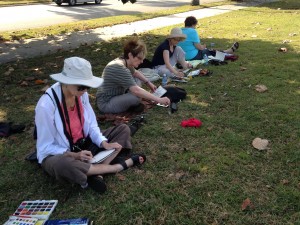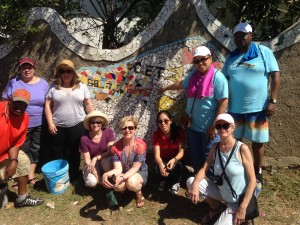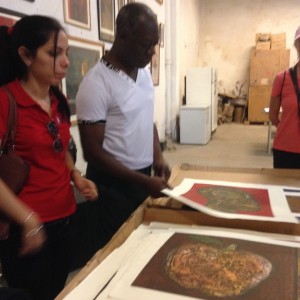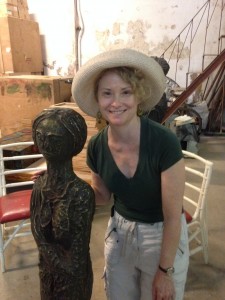My mother visited Cuba as a teenager with her family before the 1959 Cuban Revolution. I had dreamed of visiting the island. For many years, I had heard her stories and seen the black and white photos of her trip. It was forbidden or difficult to travel to the island as a US citizen ever since then. Sucheta, the director of Go Eat Give approached me about going to Cuba around Halloween 2013. We collaborated on the Art Tour of Cuba long before the historic December announcement of the Cuban thaw and in March 2015, we flew to Cuba via Cancun, Mexico. I was immediately enchanted by the vivid color and warmth of the island, both in the artwork and the people. Along the journey, we stopped to paint in our watercolor journals. While in Havana, we visited several art studios and Fototeca.

Early in the week, we met Jose Fuster, the renowned ceramic muralist who has created his own world called, “Fusterlandia” in his home and surrounding neighborhood. He had a vision to bring beauty to his home using repurposed materials. He takes broken ceramics and places them into wet cement to create a sparkling 3-D world from his imagination. When a neighbor asked for his assistance with a leaking roof, he expanded his fantasy world into the community. It continues to grow as people request his services. Fuster now creates all the designs and others complete the work under the supervision of his trusted artists.
Along with the other Go Eat Give travelers, I had a lot of fun completing the mural that was started last year on a wall two blocks from his home. We broke up recycled ceramic tiles and then positioned the colors into the wet cement. It was hot in the sun but we all enjoyed the experience immensely. We were both, elated to complete it, and sad that we didn’t have more to create. Afterwards, we reconvened at Fuster’s house to tour his ceramic studio and view his colorful tile work and paintings. His childhood friend and his son led us on the tour before Jose joined us, answered a few questions and posed for photos. Jose now requires the use of a cane, but was very active and happy to host American artists. Several of us purchased his works at great prices before retreating to a mosaic-tiled alcove to feast on a delicious lunch prepared by his staff.

We also saw the intriguing “black and white” photos of Reinaldo Echemendia, a college photography professor. His large images of bells from around Cuba resonated with all of us at Fototeca in Havana. We were not able to meet him as he was traveling out of thecountry for an art show.
Artists are given greater freedom to travel than the average Cuban citizens. It makes you wonder if they would want online art classes if this was possible, but it looks like they have plenty of options as is. They are ambassadors for the country. Interestingly and grotesquely, Echemendia developed the film using both standard film chemicals and pigs blood to give it a slightly reddish tint. Few were able to watch the detailed video of the film developing process. I wondered if it was also a statement about the blood that was shed on the island during and after the Revolution.

One of the highlights of our trip was down a sunlit alley where we were welcomed into the spacious studio of Eduardo Roco “Choco”. Born in 1949, Choco looks younger than most Cubans we met. This may be because he earned more in our one-hour visit in art sales than most Cubans earn in a year. Artists have no restrictions on what they can earn, unlike other professions including doctors and lawyers whose salaries are capped at 30-40 pesos per year.
Choco was both extremely talented in multiple mediums from printmaking to painting, sculpture and decorated ceramics. He employed 5 assistants to help create, ship and track his art plus a cook to make sure they were all well fed. A shipment of newly completed bronze statues arrived while we were on our tour. It was thrilling to watch his reaction and ours to the unveiling of the bronzes – all were very pleased! Choco was both talented and magnanimous with his time and hospitality. Like Fuster, Choco used recycled materials to create his printing plates and in his paintings and sculptures. During the “Special Time” when resources were in short supply in Cuba and continue to be even today, artists learned to use any and all materials available to them. They are very creative and resourceful. Choco is known around the world and will continue to be remembered for his visionary artwork.
~ By Kathy Rennell Forbes, an International Artist based in Atlanta, GA. She teaches art classes in the Atlanta area (Chastain Arts Center, Kennesaw State University, Studio Z) and conducts art workshops around the U.S. (Georgia, Florida, Maine, Tennessee) and Internationally (Cuba, France, Italy). Read her blog and follow her on Facebook. Join Kathy on her next Go Eat Give Art tour of Italy in October 2015.